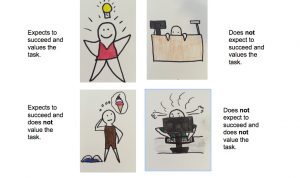The spring semester is over, summer is here, and that means faculty retreats! This year at our University of Wisconsin Health and Wellness Management retreat, a major theme we explored was student engagement. How do we keep students motivated and actively learning in online courses? Below you will find the synopsis of our session on student engagement, along with some resources if you want to learn more.

Student Engagement Resources
Our group looked at two resources on student engagement: Student Engagement Techniques by Elizabeth F. Barkley and Adding Some TEC-Variety: 100 + Activities for Motivating and Retaining Learners Online by Curtis J. Bonk and Elaine Khoo.
Small Group Discussion: What Does Engagement Mean To You?
First, we started with a small group discussion on what student engagement means. We saw both sides of the coin, where some instructors focused on barriers that the online format brings and the drudgery of discussion board. Others had uplifting stories of engagement success (one instructor talked about how a particular student’s enthusiasm on the discussion board was motivationally contagious to others—he spoke with joy when he told this story). We didn’t so much define engagement as talk about our experiences with it. In the next section, we talked about Elizabeth Barkley’s definition of engagement.
Presentation: Student Engagement Techniques by Elizabeth F. Barkley
Next, we dove into my presentation, where we discussed the following main points from Barkley’s book:
- Definition of Engagement = motivation + active learning.
- How a student expects to do on a task and how they value a task affects their motivation.
- Students’ expectations are linked with their self-perceptions.
- There are conditions, that if met, will help foster engagement:
- Promote a sense of class community.
- Help students work at their optimal level of challenge with feedback, teaching metacognitive skills, and empowering students as partners in the learning process.
- Teach so that students learn holistically – try to include the affective (emotions) and psychomotor (movement) domains.
Resources: TEC-Variety Activities to Motivate and Retain Learners Online
After that, I handed out examples of some engagement techniques from the TEC-Variety book, which is freely available online, and I highly recommend that any online educator or instructional designer check out the book and the website. I also distributed a handy map of some of the activities from the book (created by my colleague, instructional designer Laurie Berry).
Activity: Barriers, Where You Are Now, Where You Hope to Be
Finally, we ended in an activity where instructors shared their barriers, current engagement techniques, and what they hope to try in the future.
Common barriers to student engagement included:
- Lack of time (for instructors to devote to researching and developing engagement techniques)
- Simply don’t know how
- Overemphasis on grades in learning
- The online format
- Not familiar/comfortable with technology
Examples of answers to “Where am I now?” with engagement:
- Peer reviews
- Ice-breakers, discussions, case studies, variety of content delivery
- Passionately advocating for understanding the difference between engagement in the classroom versus online
- Giving lots of feedback
Examples of answers to “Where I hope to be” with engagement:
- Come up with new/better ideas (note how this is in conflict with the time barrier).
- Facilitating in the online space so that students will be actively involved in their learning and take responsibility.
- Confront fear to use technology.
- Respond to more posts.
- Online office hours using G-chat or Skype.
- Knowledge self-checks.
- Better system of auto-warning when assignments are past-due.
I hope you, reader, enjoyed the synopsis of our one-hour workshop on student engagement. I really encourage you to check out the TEC-Variety website and book (available for free online as a PDF), my presentation for some visual aids on the topic, and reflect on your own barriers, where you are now, and where you hope to be with engaging your students online.
Please share in the comments section! I’d love to hear from other educators and instructional designers on student engagement.
[…] Illustrations by Kristin Barnes […]